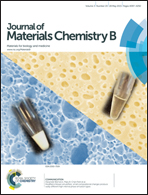l-Glutamic acid release from a series of aluminum-based isoreticular porous coordination polymers†
Abstract
We investigated the encapsulation of bioactive molecules such as L-glutamic acid (Glu) into a series of porous coordination polymers (PCPs) based on aluminum hydroxy dicarboxylates [Al(OH)(L)]n (L = dicarboxylate ligand) and the molecular release therefrom. The use of 2,6-naphthalene dicarboxylate (2,6-ndc), 1,4-benzene dicarboxylate (1,4-bdc) and 1,4-naphthalene dicarboxylate (1,4-ndc) as ligands allows us to systematically tune the pore size and the flexibility of frameworks while keeping the same topology and thus to investigate the effect of those parameters upon both adsorption and release of Glu. We revealed the impact of zwitterionic nature of Glu upon loading efficiency; optimal loading pH was shown to be that for which Glu bears both positive and negative charges. Whereas the loading capacity of PCPs is governed by the pore size ([Al(OH)(2,6-ndc)]n > [Al(OH)(1,4-bdc)]n > [Al(OH)(1,4-ndc)]n), the adsorption isotherm clearly revealed that small or flexible pores induce the stronger Glu–PCP interaction. The release experiments of Glu from PCPs in a physiological media (pH = 7.4, 37 °C) demonstrated the exceptional stabilization of Glu within [Al(OH)(1,4-bdc)]n, compared to those within the other frameworks; whereas the rigid frameworks of [Al(OH)(2,6-ndc)]n and [Al(OH)(1,4-ndc)]n spontaneously released almost the entire Glu contents within 10 h, 70% of Glu loaded within [Al(OH)(1,4-bdc)]n still remained therein over 24 h. Interestingly, the burst release of Glu was triggered by increasing temperature up to 80 °C, at which the framework changed its structure from a closed phase to the open phase.


 Please wait while we load your content...
Please wait while we load your content...